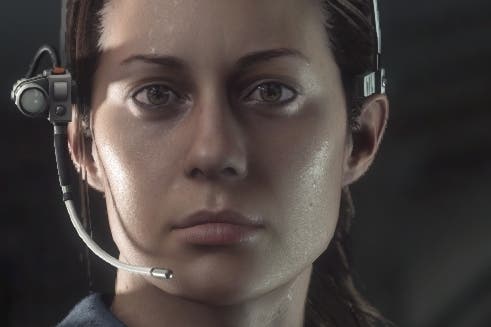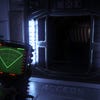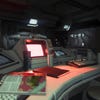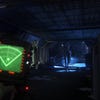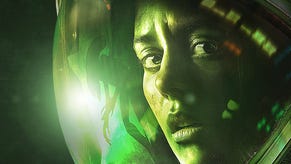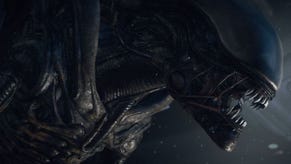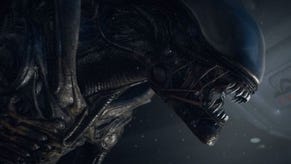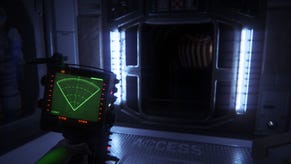How Alien: Isolation recreates the horror of the 1979 original
The xenomorph in the room.
There's something lurking in the corner of the room; something big, ugly and grotesque. It's stalking the shadows, sizing up its prey, and everybody's in fear of the havoc it's wreaked - yet no-one's willing to look it in the eye. Instead, during the first chance to play Alien: Isolation, The Creative Assembly's not-so-secret horror spin on the licence that Sega picked up in 2006 and has been fumbling with ever since, the focus is on the single xenomorph that stalks the game's corridors. And understandably so - it's quite the creation.
15 years after being abandoned by her mother, Amanda Ripley's quest for some sort of closure has sent her in pursuit of a black box recorder reportedly jettisoned from the Nostromo. Arrive, collect and leave were the orders of her employers, Weyland-Yutani, yet it's all become a little more complex than that.
Cowering in a locker in the corner of this trading post at the edge of space, Ripley sits tensely still as a nine-foot nightmare stalks the dark corridors beyond, the rising frequency of beeps from her motion tracker indicating that it's getting ever closer. A quick clamp down on the left trigger silences Ripley's ragged breathing, the edges of the screen tinged red as she becomes dizzy with the effort of it all. And just as it seems she must surely gasp out a noisy breath that would then become her last, the beast moves away out of earshot. I exhale in unison, relieved to have survived for a few more minutes at least.
It's a tense introduction to Alien: Isolation, and after the muddy mediocrity of Sega's last use of the licence it's thrilling to see the source material studied so well. Even better, it's the right source material: too many games have trodden in the noisy tracks of James Cameron's thundering tank of a movie, but too few have taken the template of Ridley Scott's 1979 original - a template that itself has its roots in schlocky horror, and one that, when appetites for interactive scares have been proven and provoked by the likes of Outlast and Slender, seems timelier than ever before.
But even as I appreciate the well-orchestrated drama that's playing out against a moodily lit backdrop, there are some prickly questions rising in the back of my mind. Why don't the rapid beeps and flashes emitted by the motion tracker belie Ripley's hiding place in spite of her best efforts to keep quiet? Why does the map screen so rudely pause the action, breaking the tension? And there's the age-old oddity that demands that game world lockers should stand ever empty and ready to serve as a safe haven, instead of being more believably stuffed to bursting with miscellaneous junk.
"We're kind of exposing ourselves in this regard because you're seeing stuff that's really early in implementation," acknowledges Al Hope, creative lead of Alien: Isolation. "We actually had a conversation about whether to take out the whole 'hiding-in-lockers thing' for this event but we decided to keep them it because it helps show our overall intent."
With a 30-minute slice of gameplay plucked from several hours into the game on offer, it's this intent that I'm left to draw impressions from. A subsequent studio tour provides a look at several key design elements that highlight the myriad references to Ridley Scott's original motion picture and the deference with which the IP is being handled. By the end of the day it's apparent to me that while I don't know what the correct unit of measurement for "intent" is, Creative Assembly has it by the bucket-load.
Alien: Isolation nails Dan O'Bannon, Chris Foss and Rob Cobb's aesthetic of a faded future that emitted such a brilliantly dull shine in 1979, and coming up to 35 years on from the original vision its charm has only blossomed. Creaking hardware and dark steel corridors take place of holographic projections and laser beams. Elsewhere, there's a dot-matrix-style hacking system, a distorted VHS quality to video displays and, of course, the familiar rudimentary nature of that motion tracker. They're encouraging nods to the original film's reliance on hand-made props rather than CGI and green screens, and it comes as a result of Creative Assembly trawling through three terabytes of source material provided by Fox Studios, which includes set designs, costume decals and unseen concept art.
Another crucial element of Alien's Haunted-House-In-Space feel is its sound design, and it's here that Al Hope and his team are doing some serious work to ensure the integrity of the atmosphere is maintained. Hope explains that, having secured the licence to use Jerry Goldsmith's original score, The Creative Assembly's sound designers then set about analysing and expanding upon it in order to create a 120-minute soundtrack to grace the finished article.
"As was the case with a lot of the first steps on this project, it was about taking this stuff that we love and expanding on it in a way that is in-keeping with the film," Hope explains. "There was this whole phase of deconstruction in terms of both visuals and audio and really trying to understand what makes this an Alien sound; to establish the DNA and motifs that make it what it is and that any fan would recognise."
This has involved creating a soundtrack that can be dynamically pitched against the on-screen action, and calling upon the services of the London Philharmonic Orchestra (the very same that lent its talent to the original Alien theme) to record the additional tracks. It's shaping up as a suitably evocative score, and just as encouraging is the attention being paid to the use of vocals and sound effects. Both Ripley's strained radio communications with her distant team and the xenomorph's chilling clicks, hisses and snarls help convey a tense feeling of helplessness and, fittingly, of isolation.
"The Alien itself has different vocals depending on what it's doing," explains sound designer Byron Bullock. "There are lots of different vocal sounds for if it thinks it's heard something, if it's actively stalking you or if it has lost your scent. If you're well enough attuned to it then you might actually start to learn these vocals and use them to your advantage towards the end of the game."

Given the focus on survival rather than domination, you're certainly going to have time enough to study the xenomorph while you're crouching behind furniture and hiding in lockers. You're also likely to be spending more time than usual with the antagonist AI.
While the individual enemy AI of a standard shooter typically exists to provide just a few seconds of resistance with the goal of moving you forward, in Alien: Isolation The Creative Assembly is looking to slow the pace right down. You'll be forced to negotiate objectives, collect items and solve puzzles while sharing claustrophobic locales with your extra-terrestrial stalker for periods of up to 20-30 minutes.
It's a fascinating proposition, but one that comes with steep challenges for the developers; the team is looking to implement an AI entity that responds both to its environment and adapts to your survival tactics. With the inventory and crafting systems missing right now there's little opportunity to test these claims, but you'll be expected to scavenge materials for use in creating makeshift survival tools. Eventually you'll be able to play a more proactive part in your own survival than cowering in the corner. However, head-on encounters will still be tantamount to suicide and the Alien will learn from your tactics - you'll have to mix it up, which will hopefully prevent repetition from dulling the persistent terror that The Creative Assembly is aiming for.
"We wanted to build something that was about instinct and unpredictability so that it's less about analysing his logic patterns and more about him as a living creature that will fight to survive," explains lead game designer, Clive Lindop.
"It's one of our biggest challenges, because this isn't just 'an alien' - it's the Alien. We're effectively going against the grain of 15 years of games where in every other iteration you've got a pulse rifle, there's loads of them and you're mowing them down. One of our primary aims is to effectively communicate to the player that this is not one of those guys. This is the original aggressive hunter."
The Creative Assembly has nailed this initial message. Watching through Ripley's eyes as the Alien unfurls from a ceiling duct and hearing her quietly terrified reaction quite simply makes me want to run and hide. But still a big question mark hangs over whether the tension of this brief slice of gameplay can be maintained throughout an entire experience - and then there's the admission that they're battling against years of conditioning that has taught us to shoot from the hip and not run for cover. You don't have to look too far back to see an example of that mentality, of course, and of how easily it can go wrong.
It's the xenomorph-shaped elephant in the room. Speaking to Hope after the demo, I ask about those who got burned by Colonial Marines' positive early showings and subsequent failure to deliver.
"We've been making this game for a long time and right from the outset we've had a really clear vision of what we're trying to achieve," Hope answers. "I think in a way, because of that, we've been naively or even arrogantly kind of blinkered because we're so focused on what we're trying to achieve.
"I do understand that there's a wider context and we've actually been talking about it recently. One of the interesting things from [Colonial Marines'] release was seeing the response on forums where people were saying, 'I want a game that's like Alien, I want that survival horror experience,' and us knowing that we have that.
"All we can do in that regard is keep going the way we're going and deliver on the promise."
The promise is there, as is the intent, and I want to believe that Creative Assembly is up to the task, and that it can improve on its patchy history of console development. As a proof of concept, Isolation undoubtedly delivers. If measured on potential alone, perhaps the developer's already done enough to slay the beasts that haunt the franchise, and to have earned a new and exciting start for the Alien series.
